Бpoнeпeхoтa: Difference between revisions
1d4chan>Piroko |
imported>Administrator m 31 revisions imported |
||
| (27 intermediate revisions by 7 users not shown) | |||
| Line 1: | Line 1: | ||
[[File:Bronepekhota.png|thumb|right|Fearless Lady Agatha in her Battle Bikini]] | [[File:Bronepekhota.png|thumb|right|Fearless Lady Agatha in her Battle Bikini. Just ignore the [[Terminator]] in the back.]] | ||
[[Бpoнeпeхoтa]] [Bronepekhota / Armored infantry] is a Russian 40mm wargame originally published by [[Tehnolog]] | [[Бpoнeпeхoтa]] [Bronepekhota / Armored infantry] is a Russian 40mm wargame originally published by [[Tehnolog]] around 2002 with more recent editions published in 2005 and 2018. | ||
==Description== | ==Description== | ||
Бpoнeпeхoтa is a miniature game similar in concept to games like Warhammer 40,000, albeit more simplified with a younger age group as the main demographic. Set in the world of CTAPCИC [STARSYS], it is a | Бpoнeпeхoтa is a miniature game similar in concept to games like Warhammer 40,000, albeit more simplified with a younger age group as the main demographic. Set in the world of CTAPCИC [STARSYS], it is a distant relative of the [[БИТВЫ FANTASY]] [Battles of Fantasy/CROSS WORLDS COMBAT] game also published by [[Tehnolog]]. Miniatures are slightly larger (40mm) than the scales common in other wargames, and vehicles utilize more action-based features such as spring-loaded launchers that tied into the gameplay. While the more affordable price point made it popular with gamers, it never saw an international release outside of Russia, Ebay, and Amazon. | ||
First launched around 2002, it featured numerous boxed sets, most of them intended as ready-to-play experiences for two players. However, at least two infantry squads of that time were targeted by a [[Chapterhouse Studios|GW lawsuit]] due to their extreme resemblance to GW miniatures (such as Ruthenian militia, similar to Valhallan IG troops, and tribunators, near-identical to space marine terminators); the molds were destroyed ([[Alpha Legion|or so they claim]]). Later, the majority of 2002 sets were discontinued. | |||
The 2008 relaunch included three mission starter kits in the Fall of 2008, each featuring two different squads and some vehicles as well; Snare Mission, Liberation Mission, and Storm Mission. Three environment sets were also released that included large urban terrain pieces that had slight variants of the force units. | |||
==Rules Overview== | |||
===2002 edition=== | |||
Understanding the rules of the 2002 edition fully requires a full rulebook to be found, which was only distributed in a single boxed set (and probably on the company site). Furthermore, there were at least two incomplete versions of the ruleset - a simplified one for small sets (that featured mechanics for "virtual fire" for infantry, which is just a fancy way of saying that they don't actually fire plastic shells) and a more comprehensive one for bigger sets (that, for some reason, did not feature infantry fire at all). Still, these two might be enough to get the overall feeling of the game. | |||
[[File:Light assault clone infantry v2002.jpg|thumb|right|A 2002 statlist ("armlist") of a Polaris Empire light assault clone infantry squad. Attributes, left to right: speed, weapon range, firepower, leadership, armor, melee, army rank, special abilities. According to some opinions, the + special ability signified a jump pack.]] | |||
The game is intended for at least two players each assembling their forces of infantry, artillery, vehicles, and fortifications on an army rating budget. For artillery and vehicles, the price calculation is straightforward - their army rank doubles as their cost. Fortifications (composed of "брониты"/"armorite" plates) cost 1/2 pt per plate, while the cost of an infantry squad is equal to the number of its members plus the entire squad's army rank (so, a squad of clones pictured here costs 7 pts).<br /> | |||
Gameplay consists of rounds. Every turn, each player generates an action point pool to use for activations and orders, which is equal to d12+their army rating, adjusted for losses and trophies. The player with higher action points for the round decides whether to activate first or second.<br /> | |||
Players then alternate, activating their units one at a time; any number and type of infantry can be connected base-to-base into a formation, which activates in its entirety. Activating the same unit more than once over the course of a round, if you have enough action points, isn't prohibited either. The possible orders for a unit include movement, shooting, attacking in melee, reforming, splitting, merging, repair, and special abilities; during an activation of a given unit, it can perform each of these (provided you have action points), but no more than once. | |||
[[File:Mortar v2002.jpg|thumb|left|A 2002 statlist ("techlist") of a mortar. Attributes, top to bottom: army rank, firing crew, movement crew, ammo, firerate, shot cost, repair.]] | |||
Movement costs are listed as "maneuver costs" for vehicles, while the cost to move a trooper unit depends on its size; that said, the cost doesn't grow quickly - it's 1 ap for 1-2 troopers, 2 ap for 3-6 troopers, 3 ap for 7-14 troopers, with higher numbers of troopers in a unit plainly unrealistic, given the nature of the game. Infantry units can hitch artillery pieces, if they are not fully stationary and there's enough troopers in the unit, and armorite cover assemblies, if there's at least one trooper in the unit per armorite plate.<br /> | |||
Ranges are measured in "steps" of 5 cm; artillery and armorite must remain within half a step of the unit that moves them. Bigger sets came supplied with standartized terrain and building pieces, where each instance of a stairway between adjacent levels equated to one step. | |||
[[File:Robotech-1 v2002.jpg|thumb|right|A 2002 statlist ("techlist") of a ROBOTECH-1 heavy combat vehicle. Attributes at the right, top to bottom: army rank, speed, maneuver cost, ammo, firerate, shot cost, repair cost. Images at the top feature armor by facing. Bottom gauge: sustained damage, with speed for this level of damage underneath. Equipment list: melee weapons and legs increase armor for the purposes of melee, small guns and missiles increase ammo reserves, big (spring-loaded) guns increase firerate, the banner increases army rank. Attributes marked with * and the big yellow message warn the player that these attributes are modified by equipment.]] | |||
Shooting costs are listed directly for vehicles and artillery, and they can fire times up to their firerate per activation, provided they have ammo left (it's refreshed every full round); while for infantry (according to the tutorial version of the rules) the costs are equal to weapon firepower, and shooting is limited to two shots per infantryman.<br /> | |||
When a vehicle or an artillery piece fires, a plastic shell is loaded into the spring-loaded gun, the gun is aimed (rotations up to 90 degrees are allowed for free), and fired (the rules forbid using mortars for direct fire, so keep that in mind). Any trooper that falls down as a result is considered slain; any trooper that stands is fine; any trooper that leans onto objects is wounded and has to roll 10+ on a d12+armor to survive. Vehicles instead suffer 1 damage (2 damage if it's a large-headed mortar shell), double that if they fall - and any following damage to fallen vehicles is doubled until they get up (with the repair order, for the listed ap cost). Artillery pieces that were hit can't be selected for the next activation; if they fall, they have to be repaired (at the listed cost).<br /> | |||
When a trooper fires, he rolls d12+firepower versus d12+armor of the target; to kill an enemy trooper or deal 1 damage to an enemy vehicle, he must roll strictly higher (not equal or higher). | |||
Fighting in melee requires physical contact; it always costs 1 ap to issue a melee assault order. Participating infantry units add together all their troopers' firepower (in the early version), melee, and armor, then roll a d12 on top of that to determine their melee score; participating vehicles add their pilots' firepower (in the early version), melee, and armor, then add the vehicle armor value on the participating facing and any armor-modifying equipment, then deduct sustained damage, then roll a d12 on top. Ties are rerolled.<br /> | |||
If two infantry units fight, the one with the higher melee score wins. The losing unit first loses its contacting troopers, then has to hit 7+ on d12+armor for each other trooper for them not to get killed as well; if any survive, they have to retreat one step away. The winning unit has to hit 7+ on d12+armor for each its contacting trooper for them to survive.<br /> | |||
Fighting vehicles is a messier affair. If you're infantry and attack a vehicle, you roll as usual; if you win, the vehicle suffers 1 damage for each trooper of the unit, but if you lose, your contacting troopers are killed, and the rest have to save on 7+. If, however, you're a vehicle and attack infantry, they're fucked - if they have no cover, they all have to hit 7+, and if they have any cover, they only roll d12+number of armorite plates for their melee score. If the vehicle loses, it suffers 1 damage, retreats, and its pilot has to hit 7+; but if the vehicle wins, it forces the infantry to hit 7+ and also destroys the cover piece outright.<br /> | |||
When two vehicles fight, they roll for melee score; the loser receives damage equal to the difference, retreats, and has to hit 7+ for the pilot. | |||
Reforming a unit (1 ap) is needed to make an infantry blob into a new shape or to rotate a vehicle more than 90 degrees in place; splitting a unit (1 ap) splits an infantry blob into two or more smaller blobs (if you wish to continue the activation, select one of the resulting parts to proceed); merging units (1 ap) merges blobs, lets blobs take artillery pieces under control, and allows infantry to board vehicles. | |||
===2005 edition=== | |||
The 2005 edition (first encountered in the "HIT!" box) changes a lot of stuff. Action points are gone, mandatory plastic shells for vehicles and artillery are gone (they can use dice too now!), infantry formations and armorite plates are gone as well. In addition, infantry is now polystyrene, not polyethylene. | |||
[[File:Light assault clone infantry v2005.jpg|thumb|right|A 2005 statlist ("armlist") for the same squad of light assault clone infantry. Top right: point cost. Attributes, left to right: army rank, speed, weapon range, firepower, melee, special abilities (Пр4 indicates a jump pack with jump length+height=4), armor. You can probably guess what do Д6, Д12, and Д20 mean.]] | |||
The game now has point costs as a dedicated attribute, as opposed to them being a function of army rank and tied into the action point system. Initiative is determined by a d12 roll-off; the game is still built on alternating activations, but, instead of infantry formations, the entire statlist's worth of infantry, regardless of their relative positions (excluding those acting as pilots), counts as a unit that activates at once. Unlike in 2002, units can't activate more than once per round, either. During a unit's activation, it can move, fire, and attack in melee (in any order, but no more than once each) if it's a ground unit; flyers have another instance of movement instead of melee combat. When an infantry unit is activated, its troopers go through this routine one at a time. | |||
Movement and ranges are still measured in 5-cm steps; however, you now have to measure distances while traversing buildings as well - gone are the days of standartized stairways. Infantry can move mobile artillery pieces; unlike the 2002 version, one trooper is enough, but movement per speed point is halved while doing so. Vehicles have different movement rules and rates depending on whether they're wheeled, tracked, legged, or flying. Wheeled and tracked vehicles use the same rates (1:1 movement rate forward and backwards, one speed point buys a rotation); walkers move two times slower backwards, but can shift sideways at half speed; flyers don't move backwards and only rotate up to 90 degrees for one speed point. | |||
[[File:Mortar v2005.jpg|thumb|left|A 2005 statlist ("techlist") of the Mortar. Top line: signifies it as a mobile artillery piece, as opposed to a stationary one. Right side gauge: ammo. Bottom gauge: integrity. Attributes, top to bottom: point cost, army rank, firerate. Weapon attributes: range, power. Shells explode in a radius of 1 step, dealing a d20-power hit to those within.]] | |||
Army rank now acts as a measure of whether a trooper can man a given artillery piece or pilot a vehicle (you need to have at least as much army rank as the machine has!).<br /> | |||
While shooting using plastic shells, every type of a shell has its own ammo cost equal to the power of that shell. Troopers that are hit but remain standing have to roll equal or under their armor on a d6, while those who fall or lean onto objects are slain; artillery pieces receive the shell power's worth of damage if they stand and twice that if they fall or are lying down already; vehicles follow rules similar to those of artillery pieces, but also have to roll equal or under their current hull integrity to see if the pilot was wounded (d12 if standing, d20 otherwise).<br /> | |||
While shooting using dice, every shot has its ammo cost equal to the number of power dice. To hit, you have to roll equal or higher than the measured range (in 5-cm steps) on the range dice; to deal damage, you have to roll over the target's armor (static for troopers, equal to current hull integrity for artillery and vehicles), with each power die counting separately and dealing 1 point of damage on a success. If a vehicle takes damage, its pilot has to roll equal or under his armor on a d6 to survive.<br /> | |||
During an activation, a trooper can fire his personal weapons once or fire an artillery piece times up to its firerate. Vehicles can fire times up to their firerate as well, but no more than once with each weapon. <br /> | |||
As an optional rule, every trooper can have grenades (a range d6 power d20 explosion 1 step/d20 personal weapon); these work a bit differently from other weapons, as they always go off when lobbed, centered on a point in range equal to the d6 result.<br /> | |||
Ammo rules are optional. | |||
[[File:Werewolf v2005.jpg|thumb|right|A 2005 statlist ("techlist") for the Werewolf heavy combat vehicle. Unlike in the 2002 version, vehicles now have faction allegiance as well; the faction logos were redesigned as well as to make them less 40k-copied. Right side gauge: ammo. Bottom gauge: current hull integrity, with relevant speed scores above. Attributes to the right of the vehicle image: point cost, army rank, firerate. Weapon attributes: range, power. ББ signifies melee. The rockets explode in a radius of 2 steps, dealing a d20-power hit to thost within.]] | |||
Melee combat requires contact (btb is ok). Troopers roll d6+melee when attacking and d6+armor when defending, while vehicles roll d6+current hull+melee regardless of whether they've started it. If the attacker can't roll over the defender, the defender suffers nothing; if the attacker does roll over the defender, the defender receives the difference as damage.<br /> | |||
When attacking from behind, you can roll the d6 twice and pick the better result; in addition, vehicles attacked from behind don't use their melee score for defense. Shooting from melee is prohibited. | |||
Capturing a vehicle without a pilot involves moving a trooper into contact and waiting until the next round for the vehicle to become operational. Capturing an artillery piece involves moving a trooper into contact as well; however, it can be fired this very round, if neither it nor its new crew did so yet. | |||
Some troopers can repair vehicles and artillery; this restores 1 hull point (and makes the machine stand up, if using plastic shell rules), but takes the trooper's entire activation, including movement (you have to start the activation in contact). It's possible to repair a vehicle you're piloting by skipping that vehicle's entire activation as well.<br /> | |||
Some troopers can jump instead of moving on foot, with maximum total length+height of the jump being equal to the jump pack's power. | |||
Other optional rules include aiming (troopers can double range dice results when firing if they forfeit all other actions, but not for grenades) and panic (troopers start running away to the closest table edge for one round if their survival roll equals their armor). | |||
===Later (around 2016 onwards) sets=== | |||
First, they remade infantry so troopers now have premolded bases; next (in latest sets), they also reduced the squad size to four troopers.<br /> | |||
No more alternating activations (it's IGOYGO now). When a unit (a trooper, an artillery piece with a trooper manning it, a vehicle, or a cyborg) activates, it can (in any order) move, fire, and fight in melee; it can also skip any of these or exchange any of these for extra movement. A trooper's speed is a function of armor; 4 steps for 4-armor, 3 steps for 5-6 armor, 2 steps for 7-8 armor, 1 step for anyone thicker.<br /> | |||
Vehicles and artillery fire using the familiar spring-loaded guns, while troopers have to rely on dice (d6+weapon power against armor, exploding on sixes; if over armor, deal damage equal to the difference; if equal to armor, deal 1 damage and, if the target is a trooper, put him face down and consider him wounded to be treated later). Some troopers have two separate ranged weapons, and this allows them to use each gun once per activation. Once per turn, you can issue a grenade throw order instead of shooting (a 3-step-range 5-power shot with a 3-power shot resolved against everyone within 2 steps of the initial target). Sufficient cover provides +2 armor to the target.<br /> | |||
If a trooper doesn't do anything but shooting during both the previous turn and the current turn, he can get +2 to the shot roll; if his target is no more than 2 steps away, he can get another +2.<br /> | |||
Wounded troopers suffer -2 armor and cannot move, but can still shoot.<br /> | |||
Plastic shells kill troopers who fall upon being hit, wound troopers who lean onto objects, and deal d6 (exploding) damage to vehicles and artillery pieces, one extra point if they fall (they are raised back afterwards). Mortars can fire large-headed shells, dealing double damage; however, you have to roll 4+ to be allowed to do so, and you only get three such shells per game. | |||
[[File:Felician specfor, latest version.jpg|thumb|left|A statlist ("armlist") for a pre-four-troopers Felician specfor squad. Attributes, left to right: shooting, melee, armor.]] | |||
Melee engagement occurs when units are no more than 1 step away from each other. Attacking in melee is simple - d6+melee vs armor, difference becomes damage if over armor, wounds if equal to armor. Melee combat is simultaneous - the target responds in a similar fashion (unless it's a vehicle or an artillery piece); both sides can die as a result.<br /> | |||
Vehicles can instead ram (d6+armor vs armor). Unlike in the 2002 version, troopers always dodge. | |||
When the turn ends, the player has to roll for every wounded trooper; wounded troopers die on 1, remain in this state on 2-4 and fully recover on 5+. | |||
As an optional rule, heavily armored troopers (the "halo/waha warriors") can be given two hit points at 8-armor and three at 9-armor. | |||
==Main Factions== | ==Main Factions== | ||
*''' | *'''[[Trade Protectorate Treaty]]''' | ||
*''' | *'''[[Polaris Empire]]''' | ||
== | ==The setting of STARSYS== | ||
[[File:Starsys Cover 2.png|thumb|right]] | |||
===Notable Characters=== | ===Notable Characters=== | ||
*[[ | *[[Lady Agatha]] | ||
*[[The Iron General]] | *[[The Iron General]] | ||
*[[Aleksey Dolgorukiy]] | *[[Aleksey Dolgorukiy]] | ||
*[[Markus the Three-Eyed]] | *[[Markus the Three-Eyed]] | ||
*[[Ghost]] | *[[Ghost/Specter]] | ||
*[[Lord Erkhard]] | *[[Lord Erkhard]] | ||
*[[Advisor Mark Chang]] | *[[Advisor Mark Chang]] | ||
| Line 33: | Line 110: | ||
*[[Advisor Elveret]] | *[[Advisor Elveret]] | ||
*[[Lord Shinji]] | *[[Lord Shinji]] | ||
*[[Advisor Olgerd]] | |||
===History and Events=== | ===History and Events=== | ||
Latest revision as of 02:54, 24 June 2023
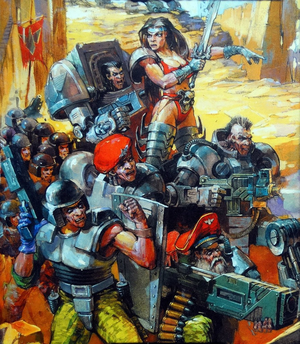
Бpoнeпeхoтa [Bronepekhota / Armored infantry] is a Russian 40mm wargame originally published by Tehnolog around 2002 with more recent editions published in 2005 and 2018.
Description[edit | edit source]
Бpoнeпeхoтa is a miniature game similar in concept to games like Warhammer 40,000, albeit more simplified with a younger age group as the main demographic. Set in the world of CTAPCИC [STARSYS], it is a distant relative of the БИТВЫ FANTASY [Battles of Fantasy/CROSS WORLDS COMBAT] game also published by Tehnolog. Miniatures are slightly larger (40mm) than the scales common in other wargames, and vehicles utilize more action-based features such as spring-loaded launchers that tied into the gameplay. While the more affordable price point made it popular with gamers, it never saw an international release outside of Russia, Ebay, and Amazon.
First launched around 2002, it featured numerous boxed sets, most of them intended as ready-to-play experiences for two players. However, at least two infantry squads of that time were targeted by a GW lawsuit due to their extreme resemblance to GW miniatures (such as Ruthenian militia, similar to Valhallan IG troops, and tribunators, near-identical to space marine terminators); the molds were destroyed (or so they claim). Later, the majority of 2002 sets were discontinued.
The 2008 relaunch included three mission starter kits in the Fall of 2008, each featuring two different squads and some vehicles as well; Snare Mission, Liberation Mission, and Storm Mission. Three environment sets were also released that included large urban terrain pieces that had slight variants of the force units.
Rules Overview[edit | edit source]
2002 edition[edit | edit source]
Understanding the rules of the 2002 edition fully requires a full rulebook to be found, which was only distributed in a single boxed set (and probably on the company site). Furthermore, there were at least two incomplete versions of the ruleset - a simplified one for small sets (that featured mechanics for "virtual fire" for infantry, which is just a fancy way of saying that they don't actually fire plastic shells) and a more comprehensive one for bigger sets (that, for some reason, did not feature infantry fire at all). Still, these two might be enough to get the overall feeling of the game.
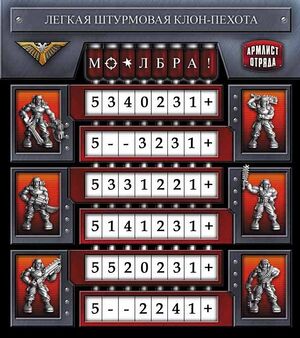
The game is intended for at least two players each assembling their forces of infantry, artillery, vehicles, and fortifications on an army rating budget. For artillery and vehicles, the price calculation is straightforward - their army rank doubles as their cost. Fortifications (composed of "брониты"/"armorite" plates) cost 1/2 pt per plate, while the cost of an infantry squad is equal to the number of its members plus the entire squad's army rank (so, a squad of clones pictured here costs 7 pts).
Gameplay consists of rounds. Every turn, each player generates an action point pool to use for activations and orders, which is equal to d12+their army rating, adjusted for losses and trophies. The player with higher action points for the round decides whether to activate first or second.
Players then alternate, activating their units one at a time; any number and type of infantry can be connected base-to-base into a formation, which activates in its entirety. Activating the same unit more than once over the course of a round, if you have enough action points, isn't prohibited either. The possible orders for a unit include movement, shooting, attacking in melee, reforming, splitting, merging, repair, and special abilities; during an activation of a given unit, it can perform each of these (provided you have action points), but no more than once.
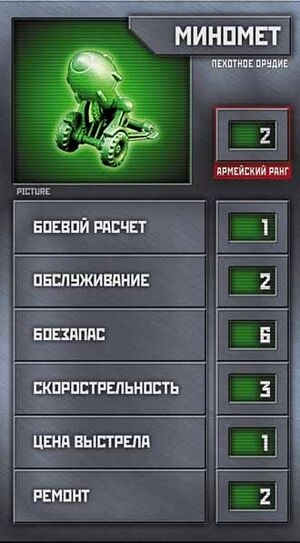
Movement costs are listed as "maneuver costs" for vehicles, while the cost to move a trooper unit depends on its size; that said, the cost doesn't grow quickly - it's 1 ap for 1-2 troopers, 2 ap for 3-6 troopers, 3 ap for 7-14 troopers, with higher numbers of troopers in a unit plainly unrealistic, given the nature of the game. Infantry units can hitch artillery pieces, if they are not fully stationary and there's enough troopers in the unit, and armorite cover assemblies, if there's at least one trooper in the unit per armorite plate.
Ranges are measured in "steps" of 5 cm; artillery and armorite must remain within half a step of the unit that moves them. Bigger sets came supplied with standartized terrain and building pieces, where each instance of a stairway between adjacent levels equated to one step.

Shooting costs are listed directly for vehicles and artillery, and they can fire times up to their firerate per activation, provided they have ammo left (it's refreshed every full round); while for infantry (according to the tutorial version of the rules) the costs are equal to weapon firepower, and shooting is limited to two shots per infantryman.
When a vehicle or an artillery piece fires, a plastic shell is loaded into the spring-loaded gun, the gun is aimed (rotations up to 90 degrees are allowed for free), and fired (the rules forbid using mortars for direct fire, so keep that in mind). Any trooper that falls down as a result is considered slain; any trooper that stands is fine; any trooper that leans onto objects is wounded and has to roll 10+ on a d12+armor to survive. Vehicles instead suffer 1 damage (2 damage if it's a large-headed mortar shell), double that if they fall - and any following damage to fallen vehicles is doubled until they get up (with the repair order, for the listed ap cost). Artillery pieces that were hit can't be selected for the next activation; if they fall, they have to be repaired (at the listed cost).
When a trooper fires, he rolls d12+firepower versus d12+armor of the target; to kill an enemy trooper or deal 1 damage to an enemy vehicle, he must roll strictly higher (not equal or higher).
Fighting in melee requires physical contact; it always costs 1 ap to issue a melee assault order. Participating infantry units add together all their troopers' firepower (in the early version), melee, and armor, then roll a d12 on top of that to determine their melee score; participating vehicles add their pilots' firepower (in the early version), melee, and armor, then add the vehicle armor value on the participating facing and any armor-modifying equipment, then deduct sustained damage, then roll a d12 on top. Ties are rerolled.
If two infantry units fight, the one with the higher melee score wins. The losing unit first loses its contacting troopers, then has to hit 7+ on d12+armor for each other trooper for them not to get killed as well; if any survive, they have to retreat one step away. The winning unit has to hit 7+ on d12+armor for each its contacting trooper for them to survive.
Fighting vehicles is a messier affair. If you're infantry and attack a vehicle, you roll as usual; if you win, the vehicle suffers 1 damage for each trooper of the unit, but if you lose, your contacting troopers are killed, and the rest have to save on 7+. If, however, you're a vehicle and attack infantry, they're fucked - if they have no cover, they all have to hit 7+, and if they have any cover, they only roll d12+number of armorite plates for their melee score. If the vehicle loses, it suffers 1 damage, retreats, and its pilot has to hit 7+; but if the vehicle wins, it forces the infantry to hit 7+ and also destroys the cover piece outright.
When two vehicles fight, they roll for melee score; the loser receives damage equal to the difference, retreats, and has to hit 7+ for the pilot.
Reforming a unit (1 ap) is needed to make an infantry blob into a new shape or to rotate a vehicle more than 90 degrees in place; splitting a unit (1 ap) splits an infantry blob into two or more smaller blobs (if you wish to continue the activation, select one of the resulting parts to proceed); merging units (1 ap) merges blobs, lets blobs take artillery pieces under control, and allows infantry to board vehicles.
2005 edition[edit | edit source]
The 2005 edition (first encountered in the "HIT!" box) changes a lot of stuff. Action points are gone, mandatory plastic shells for vehicles and artillery are gone (they can use dice too now!), infantry formations and armorite plates are gone as well. In addition, infantry is now polystyrene, not polyethylene.

The game now has point costs as a dedicated attribute, as opposed to them being a function of army rank and tied into the action point system. Initiative is determined by a d12 roll-off; the game is still built on alternating activations, but, instead of infantry formations, the entire statlist's worth of infantry, regardless of their relative positions (excluding those acting as pilots), counts as a unit that activates at once. Unlike in 2002, units can't activate more than once per round, either. During a unit's activation, it can move, fire, and attack in melee (in any order, but no more than once each) if it's a ground unit; flyers have another instance of movement instead of melee combat. When an infantry unit is activated, its troopers go through this routine one at a time.
Movement and ranges are still measured in 5-cm steps; however, you now have to measure distances while traversing buildings as well - gone are the days of standartized stairways. Infantry can move mobile artillery pieces; unlike the 2002 version, one trooper is enough, but movement per speed point is halved while doing so. Vehicles have different movement rules and rates depending on whether they're wheeled, tracked, legged, or flying. Wheeled and tracked vehicles use the same rates (1:1 movement rate forward and backwards, one speed point buys a rotation); walkers move two times slower backwards, but can shift sideways at half speed; flyers don't move backwards and only rotate up to 90 degrees for one speed point.
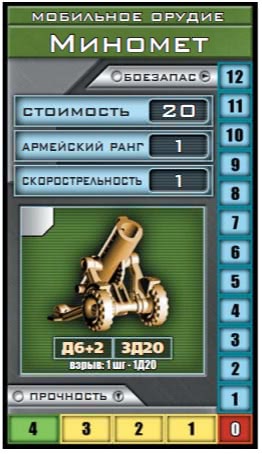
Army rank now acts as a measure of whether a trooper can man a given artillery piece or pilot a vehicle (you need to have at least as much army rank as the machine has!).
While shooting using plastic shells, every type of a shell has its own ammo cost equal to the power of that shell. Troopers that are hit but remain standing have to roll equal or under their armor on a d6, while those who fall or lean onto objects are slain; artillery pieces receive the shell power's worth of damage if they stand and twice that if they fall or are lying down already; vehicles follow rules similar to those of artillery pieces, but also have to roll equal or under their current hull integrity to see if the pilot was wounded (d12 if standing, d20 otherwise).
While shooting using dice, every shot has its ammo cost equal to the number of power dice. To hit, you have to roll equal or higher than the measured range (in 5-cm steps) on the range dice; to deal damage, you have to roll over the target's armor (static for troopers, equal to current hull integrity for artillery and vehicles), with each power die counting separately and dealing 1 point of damage on a success. If a vehicle takes damage, its pilot has to roll equal or under his armor on a d6 to survive.
During an activation, a trooper can fire his personal weapons once or fire an artillery piece times up to its firerate. Vehicles can fire times up to their firerate as well, but no more than once with each weapon.
As an optional rule, every trooper can have grenades (a range d6 power d20 explosion 1 step/d20 personal weapon); these work a bit differently from other weapons, as they always go off when lobbed, centered on a point in range equal to the d6 result.
Ammo rules are optional.
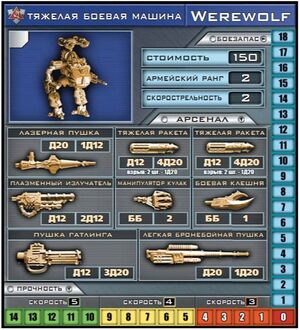
Melee combat requires contact (btb is ok). Troopers roll d6+melee when attacking and d6+armor when defending, while vehicles roll d6+current hull+melee regardless of whether they've started it. If the attacker can't roll over the defender, the defender suffers nothing; if the attacker does roll over the defender, the defender receives the difference as damage.
When attacking from behind, you can roll the d6 twice and pick the better result; in addition, vehicles attacked from behind don't use their melee score for defense. Shooting from melee is prohibited.
Capturing a vehicle without a pilot involves moving a trooper into contact and waiting until the next round for the vehicle to become operational. Capturing an artillery piece involves moving a trooper into contact as well; however, it can be fired this very round, if neither it nor its new crew did so yet.
Some troopers can repair vehicles and artillery; this restores 1 hull point (and makes the machine stand up, if using plastic shell rules), but takes the trooper's entire activation, including movement (you have to start the activation in contact). It's possible to repair a vehicle you're piloting by skipping that vehicle's entire activation as well.
Some troopers can jump instead of moving on foot, with maximum total length+height of the jump being equal to the jump pack's power.
Other optional rules include aiming (troopers can double range dice results when firing if they forfeit all other actions, but not for grenades) and panic (troopers start running away to the closest table edge for one round if their survival roll equals their armor).
Later (around 2016 onwards) sets[edit | edit source]
First, they remade infantry so troopers now have premolded bases; next (in latest sets), they also reduced the squad size to four troopers.
No more alternating activations (it's IGOYGO now). When a unit (a trooper, an artillery piece with a trooper manning it, a vehicle, or a cyborg) activates, it can (in any order) move, fire, and fight in melee; it can also skip any of these or exchange any of these for extra movement. A trooper's speed is a function of armor; 4 steps for 4-armor, 3 steps for 5-6 armor, 2 steps for 7-8 armor, 1 step for anyone thicker.
Vehicles and artillery fire using the familiar spring-loaded guns, while troopers have to rely on dice (d6+weapon power against armor, exploding on sixes; if over armor, deal damage equal to the difference; if equal to armor, deal 1 damage and, if the target is a trooper, put him face down and consider him wounded to be treated later). Some troopers have two separate ranged weapons, and this allows them to use each gun once per activation. Once per turn, you can issue a grenade throw order instead of shooting (a 3-step-range 5-power shot with a 3-power shot resolved against everyone within 2 steps of the initial target). Sufficient cover provides +2 armor to the target.
If a trooper doesn't do anything but shooting during both the previous turn and the current turn, he can get +2 to the shot roll; if his target is no more than 2 steps away, he can get another +2.
Wounded troopers suffer -2 armor and cannot move, but can still shoot.
Plastic shells kill troopers who fall upon being hit, wound troopers who lean onto objects, and deal d6 (exploding) damage to vehicles and artillery pieces, one extra point if they fall (they are raised back afterwards). Mortars can fire large-headed shells, dealing double damage; however, you have to roll 4+ to be allowed to do so, and you only get three such shells per game.
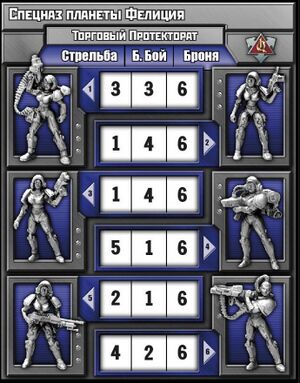
Melee engagement occurs when units are no more than 1 step away from each other. Attacking in melee is simple - d6+melee vs armor, difference becomes damage if over armor, wounds if equal to armor. Melee combat is simultaneous - the target responds in a similar fashion (unless it's a vehicle or an artillery piece); both sides can die as a result.
Vehicles can instead ram (d6+armor vs armor). Unlike in the 2002 version, troopers always dodge.
When the turn ends, the player has to roll for every wounded trooper; wounded troopers die on 1, remain in this state on 2-4 and fully recover on 5+.
As an optional rule, heavily armored troopers (the "halo/waha warriors") can be given two hit points at 8-armor and three at 9-armor.
Main Factions[edit | edit source]
The setting of STARSYS[edit | edit source]
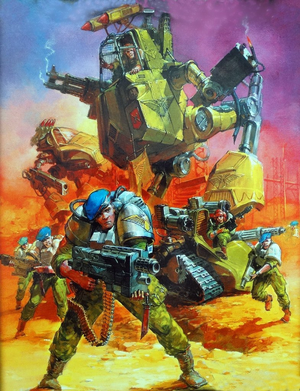
Notable Characters[edit | edit source]
- Lady Agatha
- The Iron General
- Aleksey Dolgorukiy
- Markus the Three-Eyed
- Ghost/Specter
- Lord Erkhard
- Advisor Mark Chang
- Lord Cross
- Advisor Pyriel
- Advisor Elveret
- Lord Shinji
- Advisor Olgerd
History and Events[edit | edit source]
- Бpoнeпeхoтa/A Brief History of Humanity
- The Cosmography of the Human Dominion
- Taking the Mining Complex on Rusty Shard
- Political Structure of the Protectorate and the Empire
- A Comparison of Army Structures of the Protectorate and the Empire
- Polaris: An Attempted Coup D'état During The First Wave of Invasion
- Report Regarding the Felician Conflict (Top Secret, for Protectorate Advisors Only)
- The Battle in the Void
- Battle of the Young Sprouts Fortress
- Taking the City-Planet of Velian
| Бpoнeпeхoтa Miniature Wargame | |
|---|---|
| Factions: | Dusty Zone Raiders, Militia of the Planet Velian, Pirates of Marcus, Ruthenian Guard, Spetsnaz of the Planet Felicia |